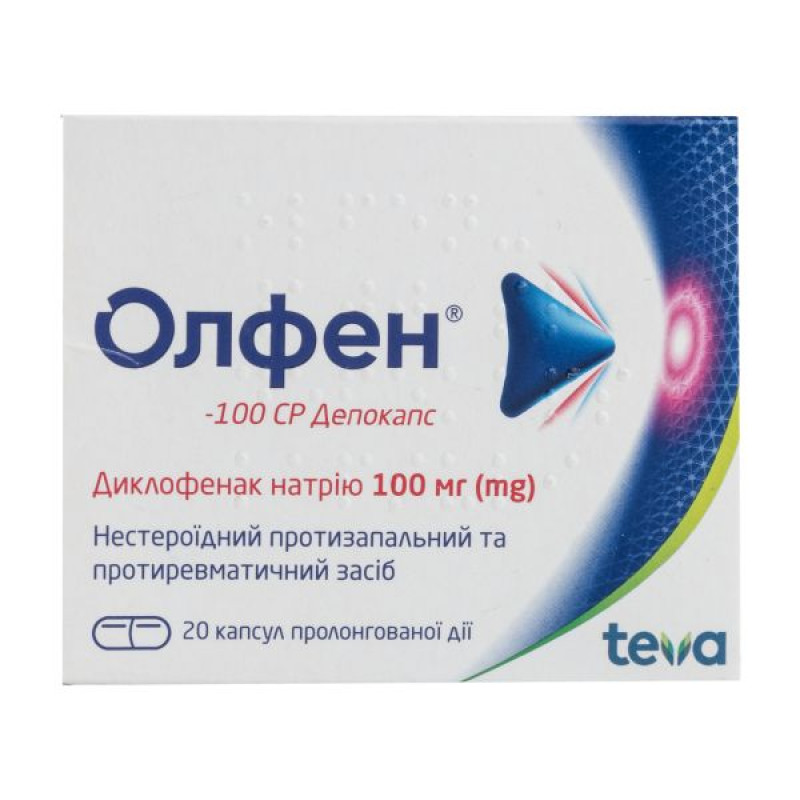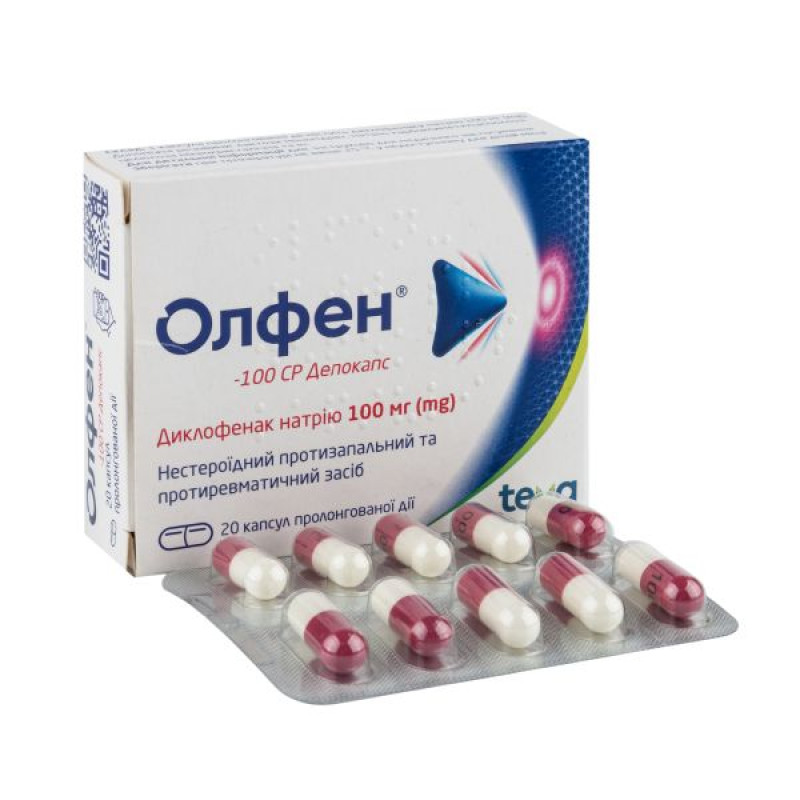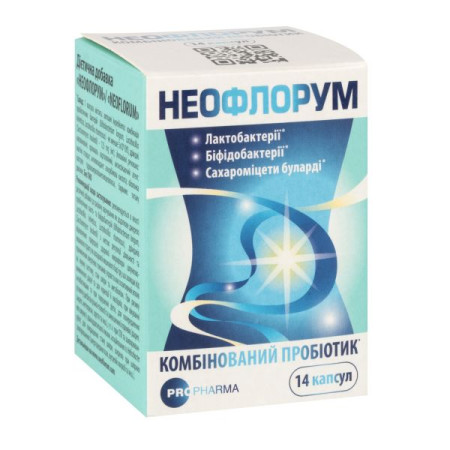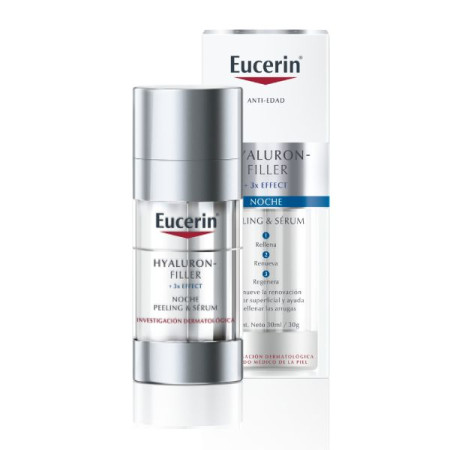Olfen-100 SR Depocaps extended-release capsules 100 mg No. 20
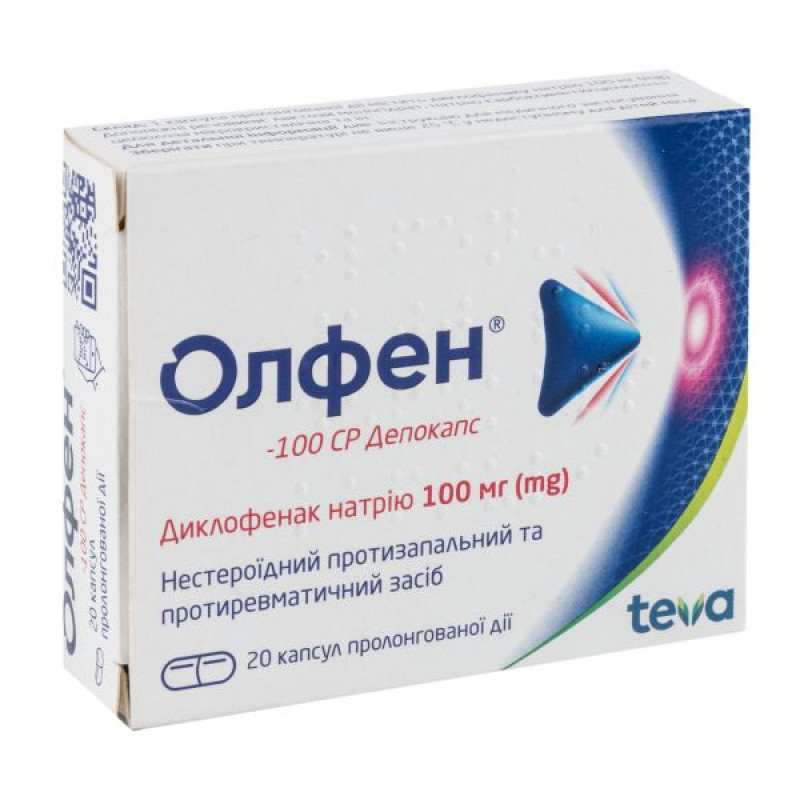
Instructions for Olfen-100 SR Depocaps extended-release capsules 100 mg No. 20
Composition
active ingredient: diclofenac sodium;
1 extended-release capsule contains diclofenac sodium 100 mg;
excipients: lactose monohydrate, microcrystalline cellulose, sodium carboxymethylcellulose-microcrystalline cellulose, glycerol trimyristate, titanium dioxide (E 171), ammonium methacrylate copolymer dispersion (type B), triethyl citrate, colloidal silicon dioxide aqueous;
capsule shell: gelatin, titanium dioxide (E 171), black iron oxide (E 172), red iron oxide (E 172), erythrosine (E 127).
Dosage form
Extended-release capsules.
Main physicochemical properties: hard gelatin capsules with a pink cap and a white opaque body, stamped "100", containing white or almost white pellets.
Pharmacotherapeutic group
Nonsteroidal anti-inflammatory and antirheumatic drugs. ATC code M01A B05.
Pharmacological properties
Pharmacodynamics
The drug Olfen®-100 SR Depocaps contains diclofenac sodium salt - a substance of non-steroidal structure, which has anti-inflammatory, analgesic and antipyretic effects. The main mechanism of action of diclofenac is considered to be inhibition of the biosynthesis of prostaglandins, which play an important role in the occurrence of inflammation, pain and increased body temperature. In in vitro studies, diclofenac sodium in concentrations equivalent to those achieved in the treatment of patients did not inhibit the biosynthesis of proteoglycans in cartilage tissue.
In rheumatic diseases, the anti-inflammatory and analgesic properties of the drug provide the most pronounced clinical effect, characterized by a significant reduction in the severity of symptoms such as pain at rest and during movement, morning stiffness and swelling of the joints, as well as improved joint function.
In post-traumatic/post-operative inflammation, Olfen®-100 SR Depocaps caused a rapid reduction in spontaneous pain and pain during movement, as well as reduced inflammatory swelling and wound edema.
Clinical studies have also demonstrated a pronounced analgesic effect of the drug in moderate to severe pain syndrome of a non-rheumatic nature.
In primary dysmenorrhea, the drug Olfen®-100 SR Depocaps reduces pain and the intensity of menstrual bleeding.
Pharmacokinetics
Absorption. After a single dose of 1 capsule of Olfen®-100 SR Depocaps, the maximum concentration of diclofenac in the blood plasma is reached after 4 hours, and its average value is 0.5 μg/ml (1.6 μmol/l). Food intake has no clinically significant effect on the absorption and systemic bioavailability of the drug.
The average concentration of diclofenac in blood plasma 24 hours after taking 1 capsule of Olfen®-100 SR Depocaps is 13 ng/ml (40 nmol/l).
After taking 1 capsule of Olfen®-100 SR Depocaps once a day, minimum drug concentrations are approximately 22 ng/ml (70 nmol/l).
Distribution: Diclofenac is 99.7% bound to plasma proteins, mainly albumin (99.4%). The observed volume of distribution is 0.12-0.17 l/kg.
Diclofenac penetrates into the synovial fluid, where the maximum concentration of the drug is reached 2-4 hours later than in the blood plasma. The observed half-life from the synovial fluid is 3-6 hours. Due to this, even 2 hours after the administration of the drug, the concentrations of the active substance in the synovial fluid are higher than in the blood plasma, and remain at higher levels for 12 hours.
Metabolism: The biotransformation of diclofenac occurs partly by glucuronidation of the unchanged molecule, but mainly by single and multiple hydroxylation and methoxylation, leading to the formation of several phenolic metabolites (3-hydroxy-, 4-hydroxy-, 5-hydroxy-, 4,5-hydroxy- and 3-hydroxy-4-methoxydiclofenac), most of which are converted to glucuronide conjugates. Two of the resulting phenolic metabolites are pharmacologically active, but to a lesser extent than diclofenac sodium itself.
Elimination. The total systemic clearance of diclofenac is 263±56 ml/min (mean ± SD). The terminal half-life is 1-2 hours. The half-life of 4 metabolites, including two pharmacologically active ones, is also short and is 1-3 hours. The practically inactive metabolite 3-hydroxy-4-methoxy-diclofenac has a longer half-life. About 60% of the drug dose is excreted in the urine as metabolites and less than 1% of diclofenac is excreted unchanged. The rest of the administered dose of the drug is excreted as metabolites through the bile and feces.
In patients with impaired liver function (chronic hepatitis, compensated cirrhosis), the pharmacokinetics and metabolism of diclofenac are similar to those in patients with normal liver function.
Indication
Pain relief and reduction of inflammation of varying degrees in various conditions, including:
joint pathology: rheumatoid arthritis, ankylosing spondylitis, osteoarthritis, acute attacks of gout;
acute musculoskeletal diseases such as periarthritis (e.g., shoulder scapular periarthritis), tendinitis, tendovaginitis, bursitis;
other pathological conditions caused by trauma, including fractures, back pain, sprains, dislocations, orthopedic, dental and other minor surgical procedures.
Contraindication
Hypersensitivity to the active substance or to any of the excipients; acute gastric or intestinal ulcer; gastrointestinal bleeding or perforation; history of gastrointestinal bleeding or perforation associated with previous treatment with non-steroidal anti-inflammatory drugs (NSAIDs); active peptic ulcer/bleeding or history of recurrent peptic ulcer/bleeding; like other NSAIDs, diclofenac is also contraindicated in patients in whom the use of ibuprofen, acetylsalicylic acid or other NSAIDs provokes attacks of bronchial asthma, angioedema, urticaria, acute rhinitis, nasal polyps and other allergic symptoms; inflammatory bowel diseases (e.g. Crohn's disease or ulcerative colitis); hepatic failure; renal failure (glomerular filtration rate <15 ml/min/1.73 m2); congestive heart failure (NYHA II-IV); ischemic heart disease in patients with angina pectoris, myocardial infarction; cerebrovascular disease in patients with stroke or transient ischemic attacks; peripheral arterial disease; treatment of perioperative pain in coronary artery bypass grafting (or use of a cardiopulmonary bypass machine); 3rd trimester of pregnancy.
Interaction with other medicinal products and other types of interactions
When using the drug Olfen®-100 SR Depocaps and/or other diclofenac preparations, the following interactions may occur.
Lithium, digoxin. When used simultaneously with these drugs, diclofenac may increase the plasma concentrations of lithium and digoxin. It is recommended to monitor serum lithium and digoxin levels.
Diuretics and other antihypertensive drugs. As with other NSAIDs, the concomitant use of diclofenac sodium with diuretics or antihypertensive drugs (e.g. beta-blockers, angiotensin-converting enzyme [ACE] inhibitors) may lead to a reduction in the antihypertensive effect of these drugs (due to inhibition of the synthesis of vasodilator prostaglandins). Such combinations should be used with caution and blood pressure should be monitored in these patients, especially in the elderly. Patients should be adequately hydrated. It is recommended to monitor renal function at the beginning of concomitant therapy and periodically during therapy, especially in the case of diuretics and ACE inhibitors, given the increased risk of nephrotoxicity (see section "Special warnings and precautions for use").
Medicinal products causing hyperkalaemia: Concomitant treatment with potassium-sparing diuretics, cyclosporine, tacrolimus or trimethoprim may be associated with increases in serum potassium and patients should be monitored more frequently (see section 4.4).
Other NSAIDs, including selective cyclooxygenase-2 inhibitors, and corticosteroids. Concomitant use of diclofenac and other NSAIDs or corticosteroids may increase the incidence of gastrointestinal side effects (e.g. gastrointestinal bleeding or ulceration). The concomitant use of two or more NSAIDs should be avoided (see section 4.4).
Anticoagulants and antiplatelet agents. Diclofenac sodium should be used with caution in combination with anticoagulants and antiplatelet agents, as their combined use may increase the risk of bleeding (see section 4.4). Although clinical studies have not shown evidence of an effect of diclofenac on the action of anticoagulants, there have been reports of an increased risk of bleeding in patients taking diclofenac and anticoagulants concomitantly. Therefore, careful monitoring of patients taking diclofenac and anticoagulants is recommended and, if necessary, adjustment of the anticoagulant dosage. Like other non-steroidal anti-inflammatory drugs, diclofenac in high doses may reversibly inhibit platelet aggregation.
Antidiabetic drugs. Clinical studies have shown that diclofenac sodium can be administered together with oral antidiabetic drugs without affecting their clinical effect. However, there have been isolated reports of hypoglycemic and hyperglycemic reactions after the administration of diclofenac sodium, which required a change in the dose of antidiabetic drugs. In this regard, it is recommended to monitor blood glucose levels during such combination therapy.
There are also isolated reports of cases of metabolic acidosis with concomitant use with diclofenac, especially in patients with pre-existing renal impairment.
Methotrexate. Diclofenac may inhibit the renal tubular clearance of methotrexate, leading to increased methotrexate levels. Caution should be exercised when NSAIDs, including diclofenac, are administered less than 24 hours before or after methotrexate, as this may increase the blood concentration of methotrexate and increase its toxicity. Serious toxicity has been reported when the interval between administration of methotrexate and NSAIDs, including diclofenac, was within 24 hours. This interaction is mediated by accumulation of methotrexate as a result of impaired renal excretion in the presence of NSAIDs.
Cyclosporine and tacrolimus: Diclofenac sodium, like other NSAIDs, may increase the nephrotoxicity of cyclosporine or tacrolimus due to its effects on renal prostaglandins. Therefore, the drug should be prescribed in lower doses than in patients not receiving cyclosporine or tacrolimus.
Quinolone antibacterials. Convulsions may occur in patients receiving concomitant quinolones and NSAIDs. Convulsions may occur in patients with or without a history of epilepsy and seizures. Therefore, caution should be exercised when considering the use of a quinolone in patients already receiving NSAIDs.
Phenytoin: When phenytoin is used concomitantly with diclofenac, monitoring of phenytoin plasma concentrations is recommended due to the expected increase in phenytoin exposure.
Colestipol and cholestyramine. These drugs may delay or reduce the absorption of diclofenac. Therefore, it is recommended to administer diclofenac at least 1 hour before or 4-6 hours after colestipol/cholestyramine.
Cardiac glycosides: Concomitant use of cardiac glycosides and NSAIDs may exacerbate heart failure, reduce glomerular filtration rate (GFR), and increase plasma glycoside levels.
Mifepristone: NSAIDs should not be used for 8-12 days after mifepristone administration, as NSAIDs may reduce the effect of mifepristone.
CYP2C9 inhibitors: Caution is advised when co-administering diclofenac with CYP2C9 inhibitors (e.g. voriconazole, sulfinpyrazone). This may lead to a significant increase in maximum plasma concentrations and exposure to diclofenac.
CYP2C9 inducers: Caution is advised when co-administering diclofenac with CYP2C9 inducers (e.g. rifampicin). This may lead to a significant reduction in plasma concentrations and exposure to diclofenac.
Application features
General: To minimize adverse effects, the lowest effective dose should be used for the shortest period of time necessary to control symptoms.
The use of Olfen®-100 SR Depocaps with systemic NSAIDs, such as selective cyclooxygenase-2 inhibitors, should be avoided due to the lack of any evidence of a synergistic effect and due to potential additive side effects.
Placebo-controlled studies have shown an increased risk of thrombotic cardiovascular and cerebrovascular complications with the use of certain selective COX-2 inhibitors. A direct correlation of this risk with the selectivity of individual NSAIDs for COX-1/COX-2 has not yet been established. In the absence of comparable clinical trial data on long-term treatment with maximum doses of diclofenac, the possibility of such an increased risk cannot be excluded. Therefore, before prescribing diclofenac, a careful risk-benefit assessment should be carried out in patients with clinically proven ischemic heart disease, cerebrovascular disorders, occlusive peripheral arterial disease or significant risk factors (such as arterial hypertension, hyperlipidemia, diabetes mellitus, smoking). Given this risk, the lowest effective dose should be used for the shortest possible duration of treatment.
As with other NSAIDs, allergic reactions, including anaphylactic/anaphylactoid reactions, may occur, even without prior exposure to diclofenac. Hypersensitivity reactions may also progress to Kounis syndrome, a severe allergic reaction that may cause myocardial infarction. Symptoms of this reaction include chest pain associated with an allergic reaction to diclofenac.
Olfen®-100 SR Depocaps, like other NSAIDs, may mask the signs and symptoms of infection.
Elderly patients (65 years and older). Caution should be exercised when prescribing the drug to individuals over 65 years of age. Although the pharmacokinetics of diclofenac are not impaired to any clinically significant extent in elderly patients, NSAIDs should be used with caution in such patients, as they are generally more prone to developing adverse reactions. In particular, it is recommended to use the lowest effective dose in debilitated elderly patients or those with low body weight, and patients should be monitored for gastrointestinal bleeding during treatment with NSAIDs.
Gastrointestinal effects: Gastrointestinal bleeding (hemorrhage, melena), ulceration or perforation, which can be fatal and can occur at any time during treatment with or without warning symptoms or a previous history of serious gastrointestinal events, have been reported with all NSAIDs (including selective COX-2 inhibitors), including diclofenac. These events are usually more severe in the elderly. If gastrointestinal bleeding or ulceration occurs in patients receiving diclofenac, the drug should be discontinued.
When using NSAIDs, including diclofenac, in patients with symptoms suggestive of gastrointestinal disorders, medical supervision and special caution are mandatory. The risk of bleeding, ulceration or perforation increases with increasing dose of NSAIDs, including diclofenac, and in patients with a history of ulceration, especially if complicated by bleeding or perforation. Elderly patients are more likely to experience adverse reactions to NSAIDs, especially gastrointestinal bleeding and perforation, which can be fatal.
To reduce the risk of such gastrointestinal toxicity, treatment should be initiated and maintained at the lowest effective dose. For such patients, as well as those requiring concomitant low-dose acetylsalicylic acid (ASA/aspirin) or other medicinal products that may increase the risk of gastrointestinal adverse effects, combination therapy with protective agents (e.g. proton pump inhibitors or misoprostol) should be considered. Patients with a history of gastrointestinal toxicity, particularly the elderly, should report any unusual abdominal symptoms (especially gastrointestinal bleeding). Caution is also required in patients receiving concomitant medications that increase the risk of ulceration or bleeding, such as systemic corticosteroids, anticoagulants (e.g. warfarin), antithrombotic agents (e.g. ASA) or selective serotonin reuptake inhibitors (see section 4.5).
The use of NSAIDs, including diclofenac, increases the risk of gastrointestinal anastomotic leakage; careful medical supervision is necessary when using diclofenac after gastrointestinal surgery.
Hepatic effects. Close medical supervision is required when Olfen®-100 SR Depocaps is prescribed to patients with impaired liver function, as their condition may worsen. When using NSAIDs, including diclofenac, the level of one or more liver enzymes may increase. The increase in enzyme levels is usually reversible after discontinuation of the drug.
This phenomenon was observed very frequently with diclofenac in clinical trials (approximately 15% of patients), but was very rarely accompanied by clinical symptoms. Most of the enzyme elevations were borderline normal. Moderate elevations (≥3 to <8 times the upper limit of normal) were common (2.5% of cases), while the frequency of severe elevations (≥8 times the upper limit of normal) remained at approximately 1%. Elevated liver enzymes were accompanied by clinically significant liver damage in 0.5% of cases in the above-mentioned clinical trials.
During long-term treatment with Olfen®-100 SR Depocaps, regular monitoring of liver function and liver enzyme levels is recommended. If liver function abnormalities persist or worsen, if clinical signs or symptoms of progressive liver disease or other manifestations (e.g. eosinophilia, rash) occur, the use of Olfen®-100 SR Depocaps should be discontinued.
Hepatitis may occur without prodromal symptoms when using diclofenac. Caution is required if Olfen®-100 SR Depocaps is used in patients with hepatic porphyria, due to the possibility of provoking an attack.
Diclofenac is contraindicated in patients with hepatic impairment. Specific studies in patients with hepatic impairment have not been conducted and no dose adjustment recommendations are available. Diclofenac should be used with caution in patients with mild to moderate hepatic impairment.
Renal effects. NSAIDs, including diclofenac, reduce the levels of prostaglandins, which are important for maintaining renal blood flow. Since fluid retention, oedema and hypertension have been reported commonly (1-10%) with NSAIDs, including diclofenac, special attention should be paid to patients with impaired cardiac or renal function, a history of hypertension, the elderly, patients receiving concomitant therapy with diuretics or drugs that significantly affect renal function, and patients with a significant decrease in extracellular fluid volume for any reason, for example before or after major surgery (see section "Contraindications"). In such cases, monitoring of renal function is recommended as a precautionary measure. Discontinuation of therapy usually leads to a return to the state that was before treatment.
Diclofenac is contraindicated in patients with renal insufficiency (glomerular filtration rate <15 mL/min/1.73 m2). No specific studies have been conducted in patients with renal impairment and no dose adjustment recommendations are available. Diclofenac should be used with caution in patients with renal impairment.
Skin effects. Serious skin reactions (some of which were fatal, including exfoliative dermatitis, Stevens-Johnson syndrome and toxic epidermal necrolysis) have been reported very rarely in association with the use of NSAIDs, including Olfen®-100 SR Depocaps (see section "Adverse reactions"). Patients are at highest risk of developing these reactions at the beginning of therapy: the onset of the reaction is noted in most cases within the first month of treatment. Olfen®-100 SR Depocaps should be discontinued at the first appearance of skin rashes, mucosal lesions or any other sign of hypersensitivity.
SLE and mixed connective tissue diseases: Patients with systemic lupus erythematosus (SLE) and mixed connective tissue diseases are at increased risk of developing aseptic meningitis.
Cardiovascular and cerebrovascular effects. Treatment with diclofenac is generally not recommended in patients with established cardiovascular disease or uncontrolled hypertension. Diclofenac should only be prescribed to patients with significant risk factors for cardiovascular events (such as hypertension, hyperlipidemia, diabetes mellitus, smoking) after careful clinical evaluation and only at doses up to 100 mg per day if the course of treatment is more than 4 weeks. Since the cardiovascular risks of diclofenac may increase with increasing dose and duration of treatment, it should be used for the shortest possible period and at the lowest effective dose. The patient's need for diclofenac to relieve symptoms and the response to therapy should be periodically reviewed, especially if treatment is continued for more than 4 weeks.
For patients with a history of hypertension and/or mild to moderate congestive heart failure, appropriate monitoring and advice is necessary, as fluid retention and oedema have been reported with NSAIDs, including diclofenac. Diclofenac should be used with caution in patients receiving concomitant diuretics or ACE inhibitors or in patients at increased risk of hypovolaemia.
Clinical trial data and epidemiological data suggest that the use of diclofenac, especially at high doses (150 mg/day) and in long-term treatment, may be associated with a small increased risk of arterial thrombotic events (e.g. myocardial infarction or stroke). Patients should be informed of the possibility of serious thrombotic events (chest pain, shortness of breath, weakness, speech disorders), which may occur without warning symptoms. In this case, a doctor should be consulted immediately.
Respiratory system effects (history of asthma). Patients with asthma, seasonal allergic rhinitis, swelling of the nasal mucosa (i.e. nasal polyps), chronic obstructive pulmonary disease or chronic respiratory infections (especially those associated with allergic rhinitis-like symptoms) are more likely to experience reactions to NSAIDs, such as exacerbation of asthma (so-called analgesic intolerance/analgesic asthma), angioedema or urticaria. Therefore, special precautions (emergency medical attention) are recommended for such patients. This also applies to patients with allergic reactions to other substances, such as rash, itching or urticaria.
Like other drugs that inhibit prostaglandin synthetase activity, diclofenac sodium and other NSAIDs can provoke the development of bronchospasm when used in patients suffering from bronchial asthma or in patients with a history of bronchial asthma.
Excipients: This medicinal product contains less than 1 mmol sodium (23 mg) per tablet, i.e. essentially ‘sodium-free’.
The drug contains lactose. Patients with rare hereditary forms of galactose intolerance, severe lactase deficiency or glucose-galactose malabsorption should not take this medicine.
Use during pregnancy or breastfeeding
Pregnancy. Inhibition of prostaglandin synthesis may adversely affect pregnancy and/or embryo/foetal development. Epidemiological studies have shown an increased risk of miscarriage, cardiac malformations and gastroschisis following the use of prostaglandin synthesis inhibitors in early pregnancy. The absolute risk of cardiovascular malformations increases from less than 1% to approximately 1.5%. This risk is thought to increase with increasing dose and duration of therapy. In animals, administration of a prostaglandin synthesis inhibitor has been shown to result in increased pre- and post-implantation losses and embryo/foetal lethality. In addition, an increased incidence of various malformations, including cardiovascular, has been reported in animals treated with a prostaglandin synthesis inhibitor during organogenesis.
From the 20th week of pregnancy, the use of diclofenac may cause oligohydramnios due to fetal renal dysfunction. This may occur shortly after the start of treatment and is usually reversible after discontinuation. In addition, there are reports of narrowing of the ductus arteriosus after treatment in the second trimester of pregnancy, most of which resolved after discontinuation of treatment. Therefore, diclofenac sodium should not be used during the first and second trimesters of pregnancy unless clearly necessary. If diclofenac sodium is used by a woman attempting to conceive or during the first or second trimester of pregnancy, the dose should be kept as low as possible and the duration of treatment as short as possible. Antenatal monitoring for oligohydramnios and narrowing of the ductus arteriosus should be considered after the use of diclofenac for several days from the 20th week of pregnancy. If oligohydramnios or narrowing of the ductus arteriosus is detected, diclofenac should be discontinued.
Diclofenac sodium is contraindicated in the third trimester of pregnancy (see section "Contraindications") due to the fact that all prostaglandin synthesis inhibitors may: expose the fetus to the following risks - cardiopulmonary toxicity (premature narrowing/closure of the ductus arteriosus and pulmonary hypertension), renal dysfunction (see above); expose the mother and newborn to the following risks - possible prolongation of bleeding time (an effect associated with inhibition of platelet aggregation, which may occur even when taking very low doses of the drug), inhibition of uterine muscle contractions, which leads to delay or prolongation of labor.
Breastfeeding. Like other NSAIDs, diclofenac passes into breast milk in small amounts. Therefore, to prevent the development of adverse reactions in infants, this drug should not be used during breastfeeding. If treatment is necessary, breastfeeding should be discontinued.
Fertility: As with other NSAIDs, Olfen®-100 SR Depocaps may impair female fertility and is therefore not recommended in women attempting to conceive. Discontinuation of the drug should be considered in women who are unable to conceive or in women undergoing investigation of infertility.
Based on relevant animal data, impaired male reproductive function cannot be excluded. The relevance of these data to humans has not been established.
Ability to influence reaction speed when driving vehicles or other mechanisms
Patients who experience visual disturbances, dizziness, vertigo, drowsiness, lethargy, increased fatigue, or other central nervous system disorders during therapy with Olfen®-100 SR Depocaps should refrain from driving or operating other mechanisms.
Method of administration and doses
The dose should be individualized. The drug should be used in the lowest effective dose for the shortest period of time, taking into account the goal of treatment for each individual patient.
Olfen®-100 SR Depocaps should be taken with meals. Swallow the capsules without chewing and with a small amount of liquid.
The daily dose is usually 1 capsule of Olfen®-100 SR Depocaps. In mild cases and with long-term treatment, this dose is usually sufficient. If it is necessary to use a dose of 50 mg or 150 mg of diclofenac sodium, treatment with Olfen®-100 SR Depocaps should be combined with taking Olfen®-50 Lactab.
In cases where the symptoms of the disease are most pronounced at night or in the morning, it is advisable to take Olfen®-100 SR Depocaps at night.
Elderly patients (65 years and older). The drug should be used with caution in such patients (see section "Special warnings and precautions for use").
Pre-existing cardiovascular disease or significant risk factors: Diclofenac should only be prescribed after careful clinical evaluation (see section 4.4).
Patients with renal impairment. The drug is contraindicated in patients with renal insufficiency (glomerular filtration rate <15 ml/min/1.73 m2). There are no recommendations for dose adjustment, prescribe with caution (see section "Special instructions").
Patients with impaired liver function. The drug is contraindicated in patients with hepatic insufficiency. There are no recommendations for dose adjustment, prescribe with caution (see section "Special instructions").
Children
The medicine should not be used in children due to the high content of the active substance.
Overdose
Symptoms. Typical clinical symptoms of diclofenac sodium overdose are unknown. In case of overdose, headache, nausea, vomiting, epigastric pain, gastrointestinal bleeding, diarrhea, dizziness, disorientation, agitation, coma, drowsiness, tinnitus or convulsions may occur. In case of severe poisoning, acute renal failure and liver damage are possible.
Treatment. Treatment of acute poisoning with NSAIDs (including diclofenac) consists of supportive and symptomatic therapy. This includes treatment of manifestations such as hypotension, renal failure, convulsions, gastrointestinal disorders, respiratory depression. Specific therapy, such as forced diuresis, hemodialysis or hemoperfusion, is of little value in the elimination of NSAIDs, given the high level of binding of these drugs to plasma proteins and extensive metabolism.
In case of overdose resulting from a potentially toxic dose of the drug, activated charcoal should be used. If the overdose resulted from a dose that is potentially life-threatening, the stomach should be emptied (induce vomiting or perform gastric lavage).
Side effects
Both with long-term and short-term use of drugs containing diclofenac sodium, the following adverse reactions may occur. The frequency of adverse reactions is distributed as follows: very common (≥1/10); common (≥1/100, <1/10); uncommon (≥1/1000, <1/100); rare (≥1/10000, <1/1000); very rare (<1/10000); frequency unknown (cannot be estimated from the available data).
From the blood and lymphatic system: very rarely - thrombocytopenia, leukopenia, anemia (including hemolytic and aplastic), agranulocytosis.
Immune system disorders: Rare: hypersensitivity reactions, anaphylactic and anaphylactoid reactions (including hypotension and shock); very rare: angioedema (including facial swelling).
On the part of the psyche: very rarely - disorientation, depression, insomnia, nightmares, irritability, psychotic disorders.
From the nervous system: often - headache, dizziness; rarely - drowsiness, increased fatigue; very rarely - paresthesia, memory impairment, convulsions, anxiety, tremor, aseptic meningitis, taste disturbance, stroke; frequency unknown - confusion, hallucinations, sensory disturbances, general malaise.
On the part of the organs of vision: very rarely - visual impairment, blurred vision, diplopia; frequency unknown - optic neuritis.
From the side of the organs of hearing and vestibular apparatus: often - vertigo; very rarely - tinnitus, hearing impairment.
Cardiovascular system: often - arterial hypertension; infrequently* - palpitations, chest pain, heart failure, myocardial infarction, arterial hypotension; very rarely - vasculitis; frequency unknown - Kounis syndrome.
Respiratory system: rarely - asthma (including shortness of breath); very rarely - pneumonitis.
Gastrointestinal: often - nausea, vomiting, diarrhea, dyspepsia, abdominal pain, flatulence, anorexia; rarely - gas
There are no reviews for this product.
There are no reviews for this product, be the first to leave your review.
No questions about this product, be the first and ask your question.




